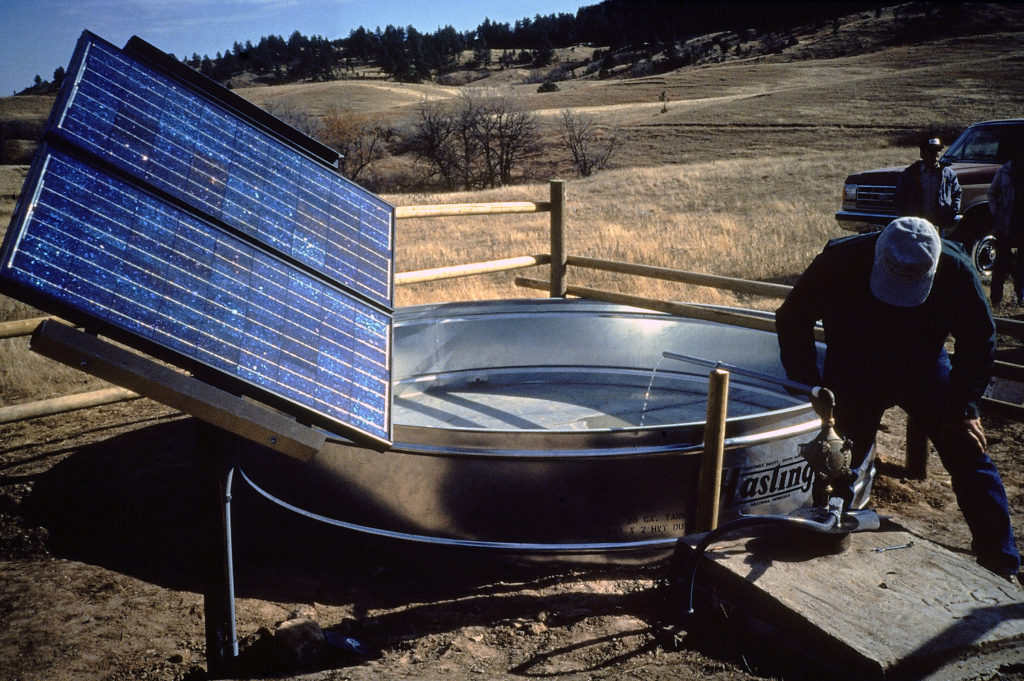
The University of Wyoming and several rural electric companies have set up rural demonstration projects to study the durability, maintenance requirements, and useful life of solar-powered water-pumping systems. Wyoming is particularly suited to use solar power because of the high elevations that results in less scattered atmospheric dispersion. Because of the vast, rural spaces in Wyoming, PV is a feasible solution to power needs in remote areas where traditional utility infrastructure is not economically viable. A medium-size solar-powered system costs about 2,000. The depth of the well and the amount of water needed on a case-by-case basis determine the size of the system.
Solar Power in Texas: Landowner Options
THE GROWING HARVEST OF OUR TEXAS SUN
| Note: Average annual irradiance in the contiguous states is 5.2191 kWh/m2/Day. 73% of the Texas land is at higher irradiance than the annual national average. |
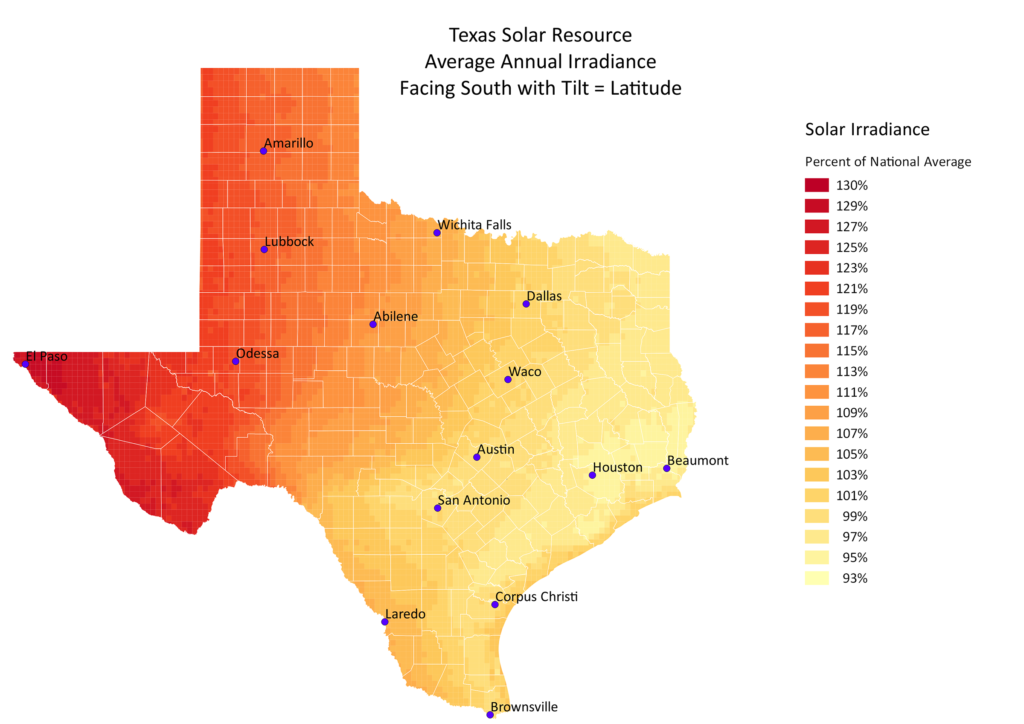
Texans do not have to be convinced of the power of the sun. Their burned hides and withered pastures are all the evidence they need. They rise early and park in the shade. They wear broad brimmed hats and rotate grazing animals through their pastures. Regardless of all precautions and adaptations, the skin still burns and the grass still shrivels. The thirtieth parallel slices Texas from the Big Bend country to Port Arthur causing temperate climates that are introduced to semi-tropical ones. No amount of wishing or cursing will ever change that.
Background information: The sun produces sunlight in the form of electromagnetic radiation that is translated to solar irradiance at the surface of the earth. Solar irradiance is a measurement of solar power at a specific location and is defined as the rate at which solar energy falls onto a surface; irradiance is typically measured in W/m² – that is watts per square meter. Solar irradiance data has been collected for many years and it is publicly available on the National Renewable Energy Laboratory (NREL) website.
The irradiance falling on a surface varies from one place to another and from moment to moment, thus the irradiance represents the rate that energy is falling on a specific location, not the total amount of energy. The total amount of solar energy that falls over a given time is called the insolation which is the power of the sun added up over some time period.
Example: If the sun shines at a constant irradiance of 1000 W/m² for one hour, we say it has delivered 1 kilo-Watt hour per square meter (kWh/m²) of energy (insolation). The amount of power is the product of the irradiance (1000 W/m²) times the length of time (1 hour) and the unit of energy is the kWh.
Solar Panels Can Replace Windmills
Out in the desert, brave and sometimes delirious ranchers attempt to raise livestock far removed from any electric line. Endless maintenance requirements and the lack of labor force the retirement of the venerable old mechanical windmills over remote wells where the animals water.
Increasingly, these shining kinetic sculptures are being replaced by small blue panels tilted toward the sun with wires down the well to a submersible pump. Within the recent years, and moving forward, the sun has emerged as more beneficial than torturous. The rancher pulls his hat off, wipes his brow and smiles at the sun. Perhaps there is peace to be made here; some new and unexpected form of friendship.
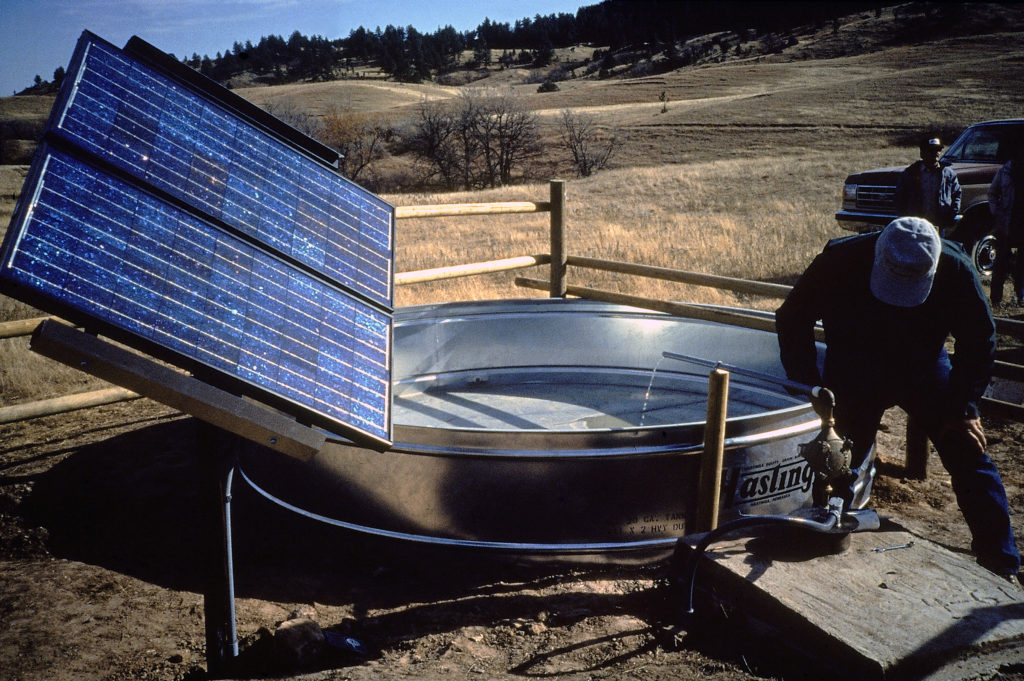
Background information: For less than $3,000 a solar water pumping system will pump up to 2000 gallons per minute with a 200 watt dc pump at 100 ft. The panels can be mounted on a slim pole and the system does not take significant space. 5 kilo-watt water pumping systems are also available for less than $5,000.
A large irrigation system of around 50 kW that may produce as much as 130,000 gallons per day (assuming 6 hours of sun per day) may cost around $60,000 and the ground mounted solar arrays may cover around 7,500 square feet.
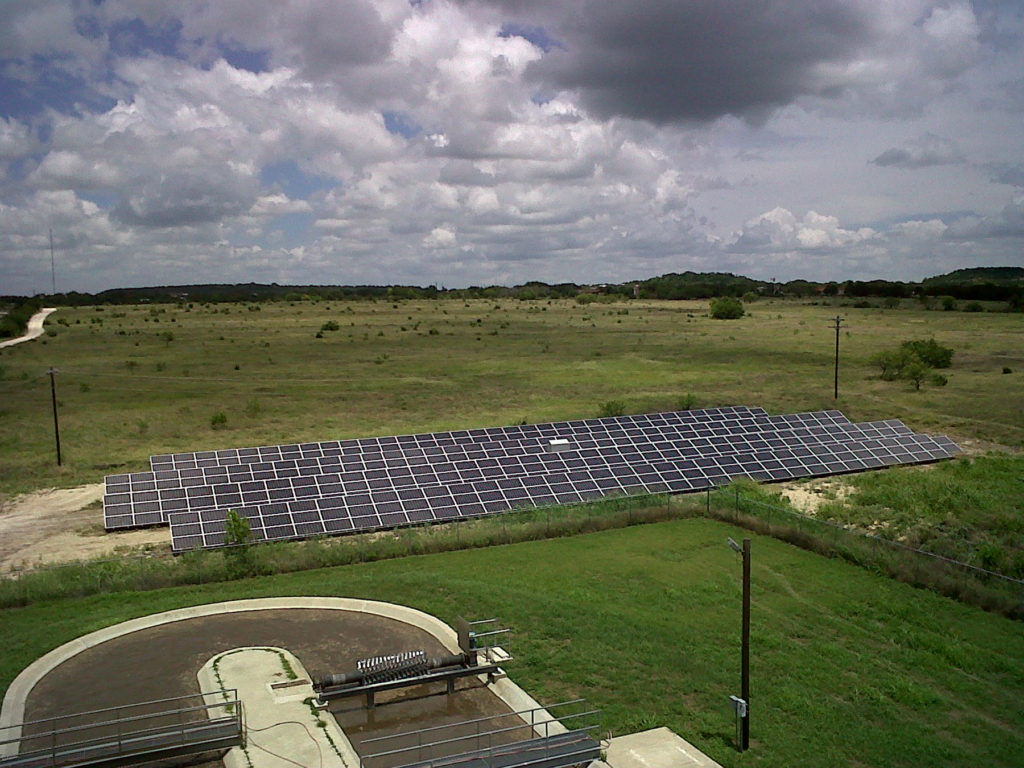
Solar Panels Can Significantly Reduce Electricity Bills for Residences and Barns
Mama is sitting in front of the air conditioner opening the mail. There is not one single piece of personal correspondence, it is all bills and advertising. She opens the electric bill and winces, it is higher than last month and higher than this month last year.
The bills for the barns, garages and processing facilities on the old home place make the house bill look nominal. There is a letter with the bill stating that, at the end of the month a new variable pricing regime will automatically take effect. What it does not spell out is that this summer the peak prices may balloon beyond imagining. There is also an advertisement for rooftop solar installation. The expense is considerable, but the power price projections make the payoff on the panels after a few years seem reasonable.
It occurs to Mama that the roof of the house has a south facing elevation and so do most of the outbuildings, making it an ample locale to take advantage of the sun as an alternative energy source for her home.
Background information: Today installing solar electric generation for a home, farm, ranch, or business is more affordable than ever. The price of solar panels has declined significantly in recent years. The overall cost and benefit of going solar is dependent on a wide range of factors such as size of the system, its location, utility rates, fees and incentives, government policies, financing options, proximity of suppliers, and more.
Some online sources of assistance in calculating the cost of going solar include:
- http://www.solar-estimate.org/?page=solar-calculator
- http://www.seia.org/about/solar-energy/solar-faq
- www.solarenergy.org/solar-calculator
- www.costofsolar.com.
Using Your Land for Large Scale Solar Electric Generation
The School Superintendent is making out a spreadsheet for next year’s budget. It is hard to keep good teachers. Their incremental salary increases must continue. The buildings are old. They are all subject to a rolling maintenance schedule. The Texas Education Agency has announced a new text book subscription. The musical instruments for the band have become dented and warped. Last year’s bond election barely passed. The largest operating expense is a shocking electrical burden, still the community tradition of Friday night lights must continue.
He looks out the window at the sunlight blazing off the parking lot. He knows the County Commissioner has the same dilemma with the baseball fields during the summer. The City Manager agonizes over the water treatment plant. Perhaps if they aggregated their usage and leveraged their advantages as public entities, they could economize with a ground mounted solar electric generating station.
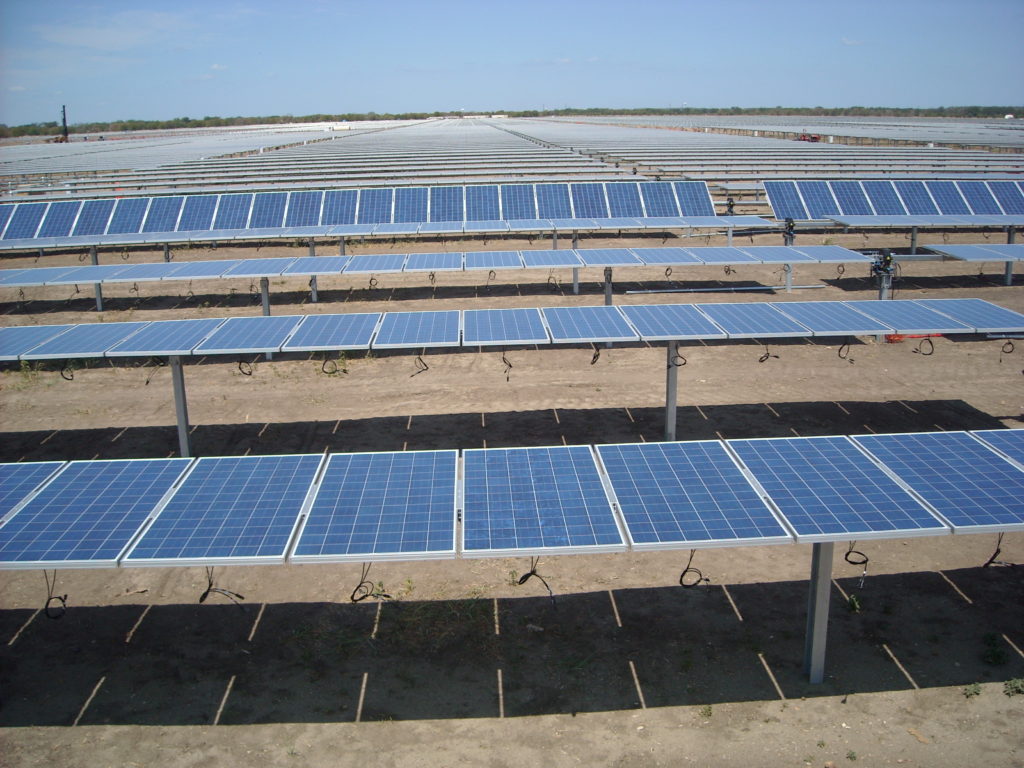
The farmer is raising dust behind the plow. The irrigation pumps are rusting even though a surprising amount of water still hides in the wells. He has to keep the tumbleweeds and mesquite saplings from invading the field. He wonders why he will spend a thousand hours on the tractor and gamble money on the seed when his chances of a decent dry land crop may be only marginal.
He has heard that reasonable royalties might be made from utility scale solar energy generation. It is a strict tradeoff with cultivation, however. It is a sole use of the land unlike wind generation that allows for multiple land uses. He speculates, ” Wind only works on the mesa tops and not down here in the valley. Besides the wind developers leased all they wanted years ago and the land owners formed wind cooperatives with the rest. Still, I have to plow around these transmission line poles every year. Maybe I will keep the old center pivot and put the rest in single tracking solar panels. It’s just another way to harvest nature and the price of diesel is breaking the bank.”
Background information: Utility-scale solar photovoltaic (PV) generation facilities in the tens of megawatts have been built in Austin, San Antonio, and Presidio (over 132 megawatts total), and such large plants are or soon will be under construction in Brackettville, El Paso, and near Pecos. With the recent rapid decline in the cost of solar panels, Austin Energy (a municipal utility) has announced it will be purchasing solar power from 150 megawatts of additional new generation priced at between 4.5 and 5.5 cents per kilo-watt hour (kWh) which is very competitive with other forms of generation. These prices reflect the application of the Investment Tax Credit (ITC) which continues in effect through 2016.
Utility-scale PV projects require approximately five to six acres per megawatt (AC) of capacity.
The red sun is setting and the heat is rising off the edge of the day. The Texans pull their lawn chairs out from under the porch and sit in the yard. They are relieved and slightly amazed they have survived another scorcher. They see that what they have may as well be considered a blessing rather than a curse. They know that tomorrow will bring a lot of sunshine. Just like the thorny pastures and the Mexican wind, the sun is a natural resource occurring locally in abundance. They say, in California, a solar industry is arising. They wonder if we can accomplish the same here.
Article provided by the Texas Renewable Energy Industries Association (www.treia.org). Written by Randy Sowell, Lionshare Advisory Services (lionsharers@hotmail.com). Contributors include Chris Holcombe, The Butler Firm (www.thebutlerfirm.com), and Electric Power Engineers, Inc. (www.epeconsulting.com).
